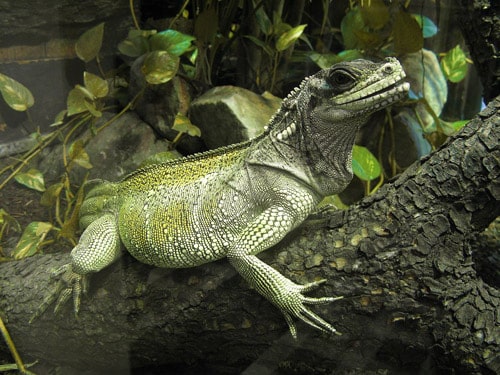Description:
Babies can be kept in a 40-gallon terrarium (minimum; bigger is better) with a cypress bark substrate and a water bowl at one end that is large enough to allow the entire lizard to totally submerge. Sailfins usually poop in their water bowl, so be sure the bowl is easily removed for daily cleaning, a must for this species. A large water feature in larger adult enclosures is a nice touch, too, as long as the pool at the bottom is deep enough and easy to clean. Place a heat lamp at one end of the enclosure to create a hot spot of about 105 to 115 degrees Fahrenheit, with an ambient temperature in the rest of the enclosure around 70 to 80 degrees. Add a UV lamp across the top of the enclosure. Lights should be on during the day and off at night. If additional heat is needed to keep the temp above 70 degrees at night, use a ceramic heat emitter or red light. Spray the enclosure every day (by hand or use a mister or fogger) to maintain humidity between 75 and 80 percent. You don’t want the bedding sopping wet, but a touch of dampness is ok Visual barriers are important because without them sailfins will smack their faces against terrarium glass. Use commercial terrarium backgrounds (such as cool ones with rain forest designs) to cover both ends and the back wall of the enclosure, and place a band measuring 6 inches across the bottom of the front glass pane. This will help the lizard see that there is a barrier there while still allowing you to observe your dragon. A pair of adult sailfins can be kept in a similar setup in a custom glass or acrylic enclosure measuring about 5 feet long, 3 feet wide and 6 feet tall. Large manufactured plastic cages work great, too; they’re expensive but worth it. Wood will rot from the humidity unless you waterproof it. In the wild, these guys like to hang out in trees overlooking or near to water, so add a tree or something else sturdy for your dragon(s) to climb on. Don’t forget the visual barriers as described previously; the band across the front pane of a 6-foot-tall enclosure should be at least 12 inches tall. The sailfin dragon is omnivorous and will eat just about anything. It loves crickets, mealworms, roaches and other insects. Leafy greens will also be accepted, as will any kind of melon, various fruits and berries. Commercial bearded dragon diets are also eaten, and are good for sailfins, too. Feed your sailfin insects dusted with a calcium supplement daily, as well as some produce or bearded dragon diet. Most H. weberi are imported from Indonesia, and this seems to be the most readily available of the three species of sailfin dragon. They are only imported sporadically, so you have to watch for them. You can also find sailfins at reptile specialty stores, reptile shows (sometimes) and online. Captive breeding of all three species is on the rise in the U.S., and more are being offered with each passing year. It’s always best to buy captive-bred sailfins if you can find them. If you have a lot of space and are willing to work with a 3-foot, possibly flighty lizard, a sailfin dragon might be for you. I recommend you have experience keeping smaller species with similar care requirements before you tackle the keeping of one of these large amazing lizards, but they sure are cool! Sailfin dragons are able to run across water on their hind legs for short distances, and are also able to remain completely submerged in water for up to an hour to escape detection by predators. Ken Foose produced his first captive-bred snakes at age 11. With a master’s degree in zoology, he has been both a zookeeper and curator. He opened Exotic Pets, which specializes in reptiles and amphibians, in Las Vegas in 1991. He is currently president of the International Herpetological Symposium.
Habitat:
Semi arboreal
Range:
Islands of Indonesia
Scientific Name: Hydrosaurus weberi
Species Group:
Family: Agamidae
Size:
Level: advanced
Weight: 3-to-5-lbs
Dangerous: No


